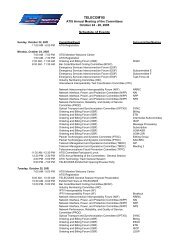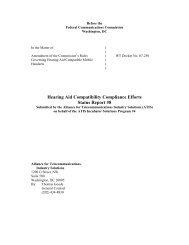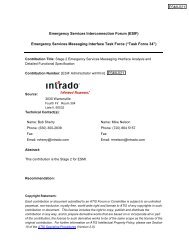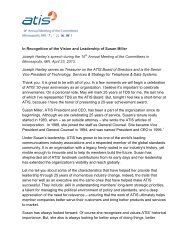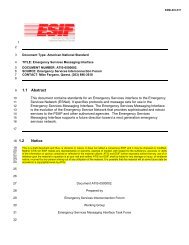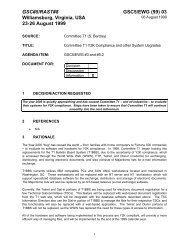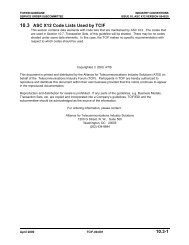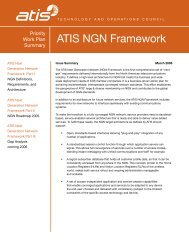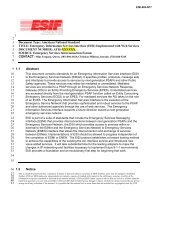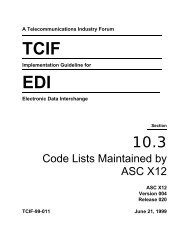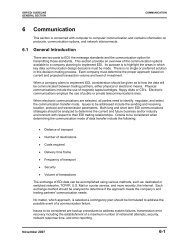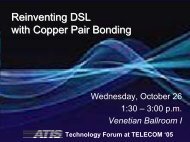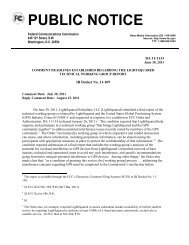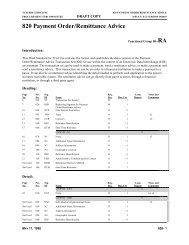Mergers and/or Acquisitions Document - ATIS
Mergers and/or Acquisitions Document - ATIS
Mergers and/or Acquisitions Document - ATIS
Create successful ePaper yourself
Turn your PDF publications into a flip-book with our unique Google optimized e-Paper software.
POINT CODES, GLOBAL TITLE TRANSLATION AND ROUTING OF MESSAGE RELAY<br />
SERVICES<br />
Netw<strong>or</strong>k elements [Service Switching Point (SSP), Signal Transfer Point (STP), Service Control Point (SCP), Home<br />
Location Register (HLR), etc.] are addressed in the SS7 Netw<strong>or</strong>k with a point code.<br />
SS7 TRAFFIC RE-HOME CONSIDERATIONS<br />
Anytime a merger <strong>or</strong> an acquisition occurs, the carrier(s) involved need to address several different areas regarding<br />
their SS7 traffic.<br />
SS7 Routing Changes <strong>and</strong> Impacts<br />
An overall traffic re-home plan is essential. All netw<strong>or</strong>ks supp<strong>or</strong>ting SS7 translations in the signaling path f<strong>or</strong> each<br />
service that each switch supp<strong>or</strong>ts must be identified. Assumptions should never be made in this area. Research<br />
must be done to determine the full path that supp<strong>or</strong>ts both query <strong>and</strong> response in the current environment, <strong>and</strong> what<br />
the new signaling path should be upon completion of the merger <strong>and</strong> acquisition. Th<strong>or</strong>ough research is a must in<br />
this area to avoid any netw<strong>or</strong>k <strong>or</strong> customer impacts.<br />
Some areas to consider when looking at your SS7 netw<strong>or</strong>k <strong>and</strong> the upcoming changes:<br />
The LNP Database may be accessed by a SS7 Transaction Capability Application Part (TCAP) query using global<br />
title as the address (the STP databases may need to be updated acc<strong>or</strong>dingly). If the merger <strong>and</strong>/<strong>or</strong> acquisition results<br />
in the calling name database having a different destination point code address then there is a need to know so that<br />
the STP Global Title Translation (GTT) Database will be updated.<br />
All STPs perf<strong>or</strong>ming the GTTs to these functions, whether in your netw<strong>or</strong>k <strong>or</strong> another netw<strong>or</strong>k, need to be updated<br />
with the new translation in <strong>or</strong>der to point to the c<strong>or</strong>rect Destination Point Code (DPC). Any updates made due to<br />
changes in the netw<strong>or</strong>k may be governed by individual company-to-company service level agreements <strong>and</strong>/<strong>or</strong><br />
interconnection agreements.<br />
Netw<strong>or</strong>k Administration <strong>and</strong> Co<strong>or</strong>dination of the Re-home<br />
Each SS7 netw<strong>or</strong>k affected by the merger <strong>and</strong> acquisition will have its own administrative requirements <strong>and</strong><br />
timeframes to make the necessary changes in their netw<strong>or</strong>k <strong>and</strong> need to be included in the overall re-home planning<br />
process.<br />
Some of the administrative requirements to make necessary changes would include: processes f<strong>or</strong> new link<br />
deployment, re-home schedules, <strong>and</strong> LIDB <strong>and</strong> CNAM database rec<strong>or</strong>ds. Some of these processes would include<br />
the use of a variety of different service <strong>or</strong>der types. If the result of the merger <strong>and</strong>/<strong>or</strong> acquisition is that data would<br />
be transferred from one database to another then:<br />
• LIDB DB Rec<strong>or</strong>ds – The transfer of LIDB rec<strong>or</strong>ds from one Database owner to another impacts routing f<strong>or</strong><br />
the entire industry, <strong>and</strong> appropriate co<strong>or</strong>dination between the Database owners is needed. When LIDB<br />
owners change, there are necessary modifications that must be made to Global Title Translation at the<br />
STPs that route various queries. Likewise, changes possibly may occur to the netw<strong>or</strong>ks <strong>and</strong> destination<br />
point codes involved in the SS7 environment. The LIDB Access Routing Guide (LARG) is the product<br />
that is recognized by the industry supp<strong>or</strong>ting the most current routing f<strong>or</strong> LIDB DB <strong>and</strong> their rec<strong>or</strong>ds (refer<br />
to www.trainfo.com f<strong>or</strong> m<strong>or</strong>e inf<strong>or</strong>mation on the LARG).<br />
• CNAM DB Rec<strong>or</strong>ds – The transfer of CNAM rec<strong>or</strong>ds from one Database owner to another impacts routing<br />
f<strong>or</strong> the entire industry, <strong>and</strong> appropriate co<strong>or</strong>dination between the DB owners is needed. When CNAM<br />
owners change, there are necessary modifications that must be made to Global Title Translation at the<br />
STPs that route various queries. Likewise, changes possibly may occur to the netw<strong>or</strong>ks <strong>and</strong> destination<br />
point codes involved in the SS7 environment. The Calling Name Access Routing Guide (CNARG) is the<br />
product that is recognized by the industry supp<strong>or</strong>ting the most current routing f<strong>or</strong> CNAM DB <strong>and</strong> their<br />
October 2009 NIIF <strong>Mergers</strong> <strong>and</strong> <strong>Acquisitions</strong> <strong>Document</strong> Page 23



